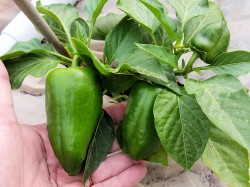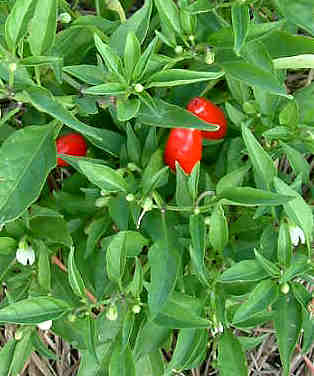How Long Do Pepper Plants Live?
How long do pepper plants live, anyway? Are they annuals, perennials or somewhere in between? Can you grow them indoors in the winter? Let’s take a look at the life of a pepper plant.
Note: In the years since I have written this post I have had more experiences with keeping pepper plants going — here’s my new post. (Read this one first, though, because it has additional information.)
Pepper Types (Species)
There are five main species of peppers:
- Capsicum annuum:Â Includes bell, sweet and many standard chile peppers like ancho, jalapeno, cayenne and more.
- Capsicum chinense:Â Includes datil, habanero and scotch bonnet peppers.
- Capsicum frutescens:Â Includes tabasco and thai peppers.
- Capsicum pubescens:Â Includes the South American rocoto peppers.
- Capsicum baccatum:Â Includes the aji peppers.
It’s important to know the species, as some are longer-lived than others. All pepper plants can be grown as annuals, but a few species can be perennial, provided they are in very warm, tropical climates.
There’s one pepper that seems to be cross-species, and that is the naga / bhut jolokia pepper. Originally called Capsicum frutescens, DNA testing has found some Capsicum chinense genes as well.
Capsicum Chinense as a Perennial
The Capsicum chinense peppers can live several years, providing they are in a warm climate. In theory, this means you can grow this species in a warm greenhouse as a perennial.
I’ve grown habaneros almost perennially here in South Florida, but I’m afraid that some of our cold snaps have done them in. This year I am trying habaneros and datils in containers, so that I can move them into the house (well, garage at any rate) when the temperatures fall below 45 degrees.
Capsicum Annuum
Your average pepper plant belonging to the species Capsicum annuum is generally grown as an annual. Although I have had some pretty long-lived jalapenos, they eventually get woody and die off.
I’ve never tried pruning a jalapeno, though, to see if I can revitalize it — that’s something I’ll have to try this year.
Although you really can’t grow them as a true perennial, Capsicum annuum can have an extended season. If you’re growing your pepper(s) in a container, you can try moving them indoors when the weather cools down. Just keep in mind that your pepper still needs plenty of sunlight; without sunlight, all the warmth in the world won’t extend your pepper’s life. That may mean a combination of south-facing window along with some supplemental light (grow lights).
Other Pepper Species
The same general rules apply to the other species; they need warmth and plenty of sunlight in order to keep growing. In their native tropical environments, the plants can live multiple years. But even in South Florida, they won’t necessarily live all year around — we do get chilly weather, and even as I write this, I’m expecting freezing temperatures tomorrow night.
So how long do pepper plants live? While they may not be perennial in the sense of living years on end, there are varieties that can grow several years — if you have the right climate.
Additional Reading
You might enjoy these related posts on peppers:
Pepper Plants and Seeds
Pepper plants and seeds are fun to work with (as you probably already know). So today is an update on the peppers and chiles that I have on deck — plants and seeds.
Bell Pepper, Yellow
This is a plant that I bought, with hopes of getting some more bells. As you’ll remember in some of my growing peppers in Florida posts, I traditionally have a hard time with bell peppers. This time I decided to just buy a plant and hope for the best.
It’s doing fairly well, and some blossoms are getting ready to appear — at least six so far. I’d have liked the plant to be a little larger, but I’ll see what happens. The size may have something to do with the fact that it’s been cooler than normal these last few weeks — days in the 60’s to low 70’s, nights in the 40’s.
Sweet Banana Peppers
The next on deck and growing well are the Sweet Banana peppers. I love the sweet bananas, and they are still a way from planting out in the garden, but they’ve been doing well, in spite of the cooler weather (I have them outdoors in a protected location).
Redskin Bell
Redskin, a bell with a “weeping” habit, is doing well. I figured I’d try another kind of bell, and grow it out on the screened patio in a pot, see what happens.
Purira Chile Pepper
I love growing the hot peppers that look like Christmas trees, with candles of all kinds of colors. Purira is a pretty hot pepper with tons and tons of cone-shaped fruits. Colors vary between ivory, yellow, purple, orange and red, with all colors appearing at any given time. Ornamental, but drop one small ripe pepper in a pot of chile and watch out!
Pretty in Purple Pepper (Hot)
Pretty in Purple is one is another of the ornamental but hot peppers. The leaves and stems are mostly purple, and the peppers are purple, ripening to red hot red. Put one or two in your chili for a nice heat.
Sweet Pickle
Name notwithstanding, I like to eat these Sweet Pickle peppers fresh. Kind of remind me of the Purira chile, with a Christmas tree appearance. These are great sliced up in salads, soups and salsa. Not hot at all — just sweet. One of these days I’ll have to try pickling them.
The Really Hot Chiles
My bhut jolokia has arrived, and I’m waiting for the mustard habaneros to show up. Thai hot, peter pepper, datil and hot-banero are also waiting in the wings. Hot-banero is the hottest habanero I’ve ever grown (my own strain), and I want to see how it stacks up against jolokia and the mustard habanero.
I’m not in a super-hurry for the really hot peppers; they like the warmth and it’s still pretty cool. In my experience, the hotter the pepper, the warmer the soil it needs to germinate, and the longer it takes to germinate. I don’t plan on putting any of the really hot chiles out in the garden until maybe the beginning of March.
But I will very shortly be germinating some jalapeno seeds — Jalapeno M variety. Debating on trying the Jaloro as well; those are some of my legacy (i.e. 10-year-old) seeds. Germination for the older seeds has been kind of low, but we’ll see what happens. Jaloro is a yellow jalapeno, instead of the usual green. But I like to use it red, which gives it a really nice kick.
Growing Chile Peppers
So, is growing chile peppers any different than growing bell or sweet peppers? Overall growing is the same, but there are some special considerations for hot chile peppers. And the hotter the pepper, the more important these differences become.
What’s the Scoville Rating of the Pepper?
You should be aware of the Scoville rating of your chosen peppers. The what rating? If you’re not familiar with it, check out the about chile peppers post to find out about the Scoville scale. Then come back here and read on!
The reason you need to know about the general Scoville rating is that the higher the Scoville, the warmer the peppers like it! This includes everything from germination to growing weather.
I personally have noticed a difference in temperatures for germinating seeds for non-chile peppers versus the hot ones. And also within the peppers based on their heat. My sweet pepper seeds almost always germinate faster than the chiles. In fact, I’m seeing it right now, with the latest batch of seeds (sweet and chile) that I am germinating. So far, it’s just the sweet/bell peppers that have popped their head above soil.
So growing chile peppers starts with warmer germination temperatures. If you want information about a way to keep the growing medium warmer than usual, check out the growing peppers in Florida post.
Growing Chile Peppers – Containers or Garden?
Most chile peppers don’t grow terribly large, so are fine for growing in containers if that’s your wish. The peppers that seem to always grow larger for me are the jalapeno peppers, so if you grow them in a container, make it a larger container. When happy in the garden, I’ve had jalapenos grow over 4 feet tall. Let me tell you — that was a lot of jalapenos!
Now here’s something anecdotal. In my experience, the hotter the pepper, the shorter the pepper grows.  It doesn’t mean a shorter pepper isn’t just as prolific as the larger peppers, though. In fact, the very hot chile peppers like Bolivian Rainbow (which I grow for ornamental and eating purposes) bears smaller peppers but tons of them! But these peppers rarely grow more than about 20 inches tall.  This isn’t a hard and fast rule, though — there are some habaneros that can grow 3 feet tall.
I’ve just ordered some bhut jolokia seeds, which happens to be the hottest pepper in the word these days (1,000,000+ Scoville). So I’ll see if they need even warmer soil and weather conditions. And I’ll see how tall they grow, compared to my average-sized habaneros.
Chile Pepper Weather
Keep in mind that chile peppers originated in Central America, so you know they love hot weather. And interestingly, some hot peppers like habaneros and scotch bonnets can live as a perennial in a climate with warm weather year ’round.
The farther north you grow them, the more hours of direct sunlight your chile pepper plants need. (Here in South Florida in the summer, I make sure they get morning and afternoon sunlight, but have dappled shade mid-day; our sun is strong!)
So keep your chile pepper seeds warmer during germination (up to 95 degrees for the hottest peppers), although 85 tends to be the best overall temperature. Make sure you plant your peppers in a very warm area of your garden with plenty of sunshine, but which still has good air circulation. Give them some fertilizer (I prefer organic fertilizers) and keep the soil damp, but not wet.
Then, enjoy the harvest of your chile peppers!